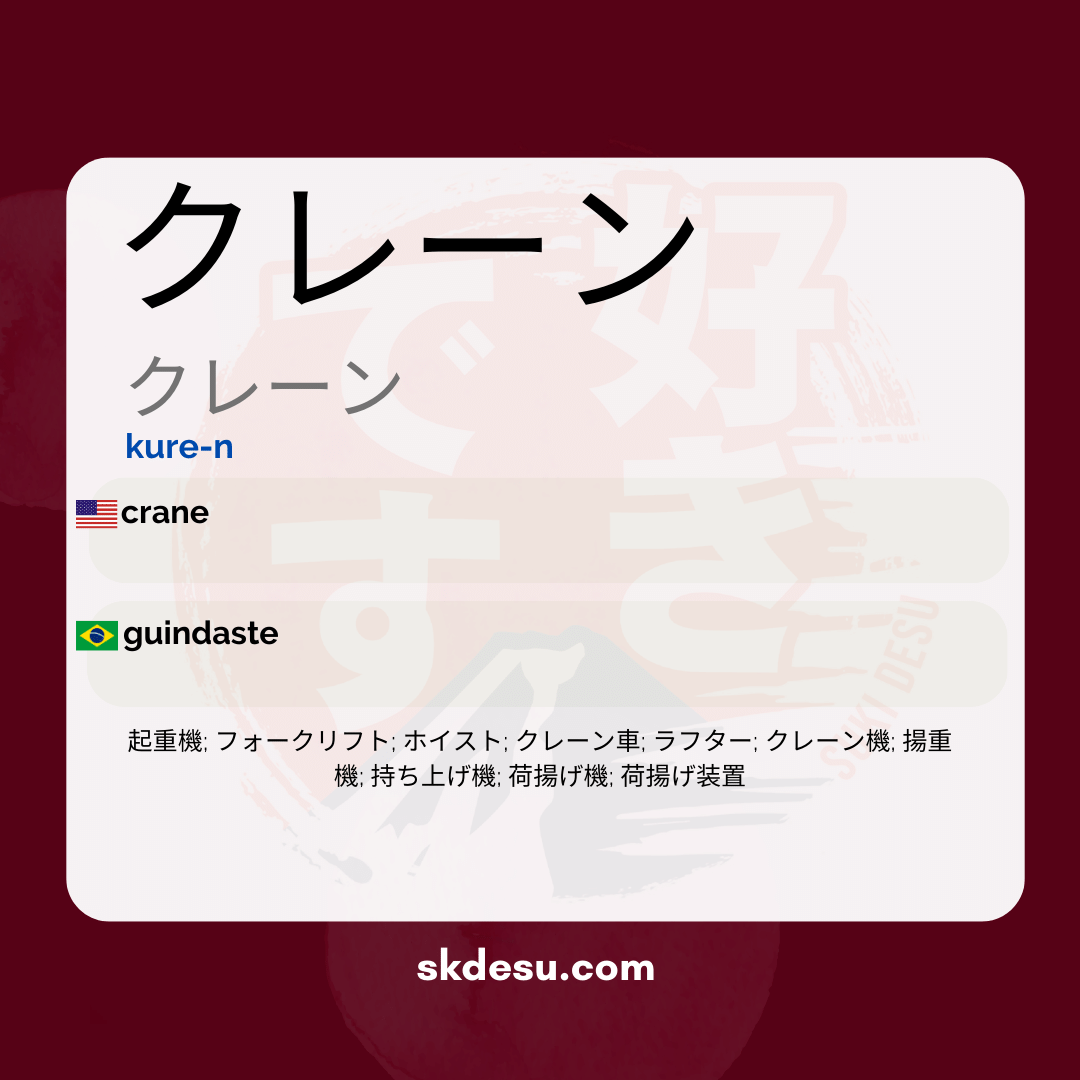Translation and Meaning of: クレーン - kure-n
The Japanese word クレーン (kure-n) refers to a "crane." This expression is borrowed from the English "crane," which means the same. The use of borrowed words, known as gairaigo, is quite common in the Japanese language, especially for technical terms or objects that were not originally part of Japanese culture.
Etymologically, the word クレーン (kure-n) reflects the influence of the West in Japan, especially during the Meiji period when the country began to modernize its infrastructure and adopt Western technologies. This cultural exchange led to the use of foreign vocabulary, resulting in the introduction of words like this. The crane is an essential machine in construction and transportation, symbolizing innovation and efficiency in the industry.
Definitions and Functions
The crane is a machine designed to lift, move, and position heavy loads efficiently. There are several types of クレーン (kure-n), each suitable for different purposes and work environments. Some of the categories include:
- Mobile cranes
- Fixed cranes
- Tower cranes
- Hydraulic cranes
These machines are crucial on construction sites and in industries, allowing the safe and practical movement of heavy materials.
Use in Popular Culture
The word クレーン (kure-n) can also be seen outside of the industrial context. In some narratives of popular culture, such as anime and mangas, cranes can be depicted as elements of overcoming and support, symbolizing help in difficult times. This shows how technology plays not only a functional role but also a symbolic one in Japanese society.
In summary, クレーン (kure-n) is not just a technical term, but also a symbol of the meeting between the West and Japan, in addition to playing a significant role in modern cultural narrative. The use of the term illustrates the adaptability of the Japanese language and its ability to incorporate new influences over time.
Vocabulary
Expand your vocabulary with related words:
Synonyms and similar words
- クレーン車 (kurēn-sha) - Vehicle equipped with a crane for handling loads.
- フォークリフト (fōkurifuto) - Equipment for lifting and moving pallets and heavy loads, mainly in warehouses.
- ホイスト (hoisuto) - Mechanical device used to lift or lower loads, usually with a cable.
- ラフター (rafutā) - Mobile crane that can operate on uneven terrain.
- 起重機 (kiyūki) - General equipment for lifting heavy loads, often used in construction.
- 揚重機 (yōjūki) - Equipment specifically designed to lift and transport heavy loads.
- 持ち上げ機 (mochiageki) - Machine or device that lifts objects.
- 荷揚げ機 (niageki) - Equipment used to unload and lift loads.
- 荷揚げ装置 (niage sōchi) - Device or system used for lifting loads.
Related words
Romaji: kure-n
Kana: クレーン
Type: noun
L: jlpt-n1
Translation / Meaning: Crane
Meaning in English: crane
Definition: Machines used on construction sites, etc.
Quick Access
- Vocabulary
- Writing
- Sentences
How to Write in Japanese - (クレーン) kure-n
See below a step-by-step guide on how to write the word by hand in Japanese. (クレーン) kure-n:
Example Sentences - (クレーン) kure-n
See below some example sentences:
Kurēn wa omoi mono o mochiageru tame ni tsukawareru kikai desu
Crane is a machine used to lift heavy objects.
A crane is a machine used to lift heavy objects.
- クレーン (kurēn) - Crane
- は (wa) - Topic particle
- 重い (omoi) - heavy
- 物 (mono) - object, thing
- を (wo) - direct object particle
- 持ち上げる (mochiageru) - lift
- ために (tameni) - in order to
- 使われる (tsukawareru) - be used, be used
- 機械 (kikai) - machine
- です (desu) - to be, to be (polite form)
Other Words of this Type: noun
See other words from our dictionary that are also: noun

